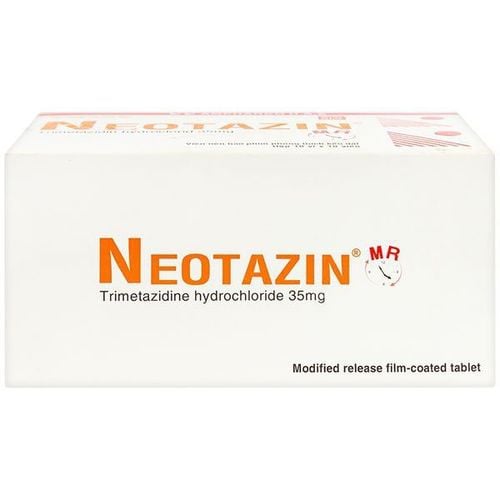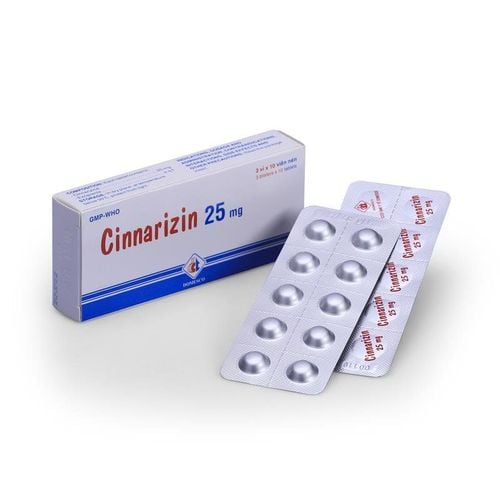This is an automatically translated article.
Vasranta 20 belongs to the group of cardiovascular drugs, used to help dilate blood vessels in the treatment of angina and other conditions. The following article will help patients understand the uses, indications and doses of Vasranta 20, thereby helping to improve treatment effectiveness and prevent side effects.
1. Uses of Vasranta 20
Vasranta 20 is a drug belonging to the group of cardiovascular drugs. Ingredients of Vasranta 20 include: Trimetazidine hydrochloride 20mg, Excipients: Tapioca starch, magnesium stearate, lactose, povidone, hydroxypropylmethylcellulose, polyethylene glycol 6000, ponceau 4R color, talc, erythrosine color, black iron oxide color and ethanol 96%. Trimetazidine inhibits the long-chain 3-ketoacyl-CoA thiolase enzyme in ischemic b cells, thereby inhibiting the oxidation of fatty acids. On the other hand, glucose oxidation requires less oxygen than oxidation. Therefore, promoting glucose oxidation will help optimize cellular energy metabolism, helping to ensure energy retention during periods of anemia.
In patients with myocardial ischemia, trimetazidine acts as a metabolite, helping to conserve energy levels in myocardial cells, thereby helping to combat ischemia without affecting hemodynamics .
2. Indications and contraindications of Vasranta 20
2.1. Indications Vasranta 20 is indicated for the treatment of:
Adjunctive or adjuvant therapy in patients with inadequately controlled angina; Persons intolerant to other angina therapies; Prevention of angina after myocardial infarction; People with visual impairment, hypothetical market due to circulatory disorders; Treatment of symptoms of tinnitus, dizziness. 2.2. Contraindications of the drug Vasranta 20 Vasranta 20 drug must not be used in the following cases:
People with hypersensitivity to Trimetazidine hydrochloride or any of its ingredients; Parkinson's patients or Parkinson's symptoms; Restless legs syndrome ; Severe renal impairment with creatinine clearance less than 30 ml/min.
3. Dosage and how to use Vasranta 20
Usage: Vasranta is used orally. The drug is absorbed and reaches maximum plasma concentrations 2 hours after administration. Patients should take the entire Vasranta 20mg tablet, do not chew, break, or crush it because it can reduce the effectiveness of the drug. Vasranta should be taken with a meal.
Dosage:
Recommended: 1 tablet 20mg/time x 3 times/day. Patients with renal failure with creatinine clearance from 30-60ml/min: 1 tablet 20mg/time x 2 times/day. Elderly: Use the same dose as adults, no dose adjustment is required. Children: There is no information on the safety and effectiveness of Vasranta 20 in children.
4. Side effects of the drug Vasranta 20
Patients may experience some unwanted side effects while using Vasranta 20 such as:
Nervous system disorders: Headache, dizziness, Parkinson's symptoms such as tremor and slow movement. Cardiovascular disorders: Palpitations, palpitations, extrasystoles. Gastrointestinal disorders: Anorexia, belching, nausea, vomiting, abdominal pain and diarrhea. Skin and subcutaneous tissue disorders: Rash, pruritus, urticaria and pustules. General disorders: Asthenia. Before prescribing a drug, doctors always weigh the benefits of Vasranta 20 against the risk of unwanted effects. However, some patients may still experience these effects during treatment. Therefore, if any abnormality occurs while taking Vasranta 20, the patient should notify the doctor for guidance on management.
5. Vasranta 20 . drug interactions
Vasranta 20 may interact if used concurrently with the following drugs and substances:
Isocarboxazid; Mephenesin ; Tranylcypromine; Drugs belonging to the class of MAOI inhibitors.
6. Be careful when using drugs
During the use of Vasranta 20, patients should note:
The active ingredient Trimetazidine in Vasranta may cause or worsen Parkinson's symptoms such as increased muscle tone, slow movement and tremor. When there are signs such as tremor, unsteady gait, restless leg syndrome, you should stop taking the medicine immediately and consult a doctor. Symptoms of dyskinesia are usually reversible after 4 months of discontinuation of the drug. In people being treated for high blood pressure, there may be falls, unsteadiness and a drop in blood pressure. Patients may experience symptoms such as dizziness, blurred vision, affecting the ability to drive and use machines. The safety of Vasranta 20 for pregnant women has not been established, so to limit the risk to the fetus, do not use Vasranta unless directed by your doctor. Lactation: There are currently no studies on the excretion of Vasranta 20 in breast milk, therefore the best option is not to use the drug in women who are breastfeeding. Above is all information about Vasranta drug uses, dosage and important notes when using. To ensure safe and effective use of the drug, patients need to carefully read the instructions for use, strictly follow the indications and doses. If you have any questions about Vasranta, you should consult your doctor or pharmacist.













